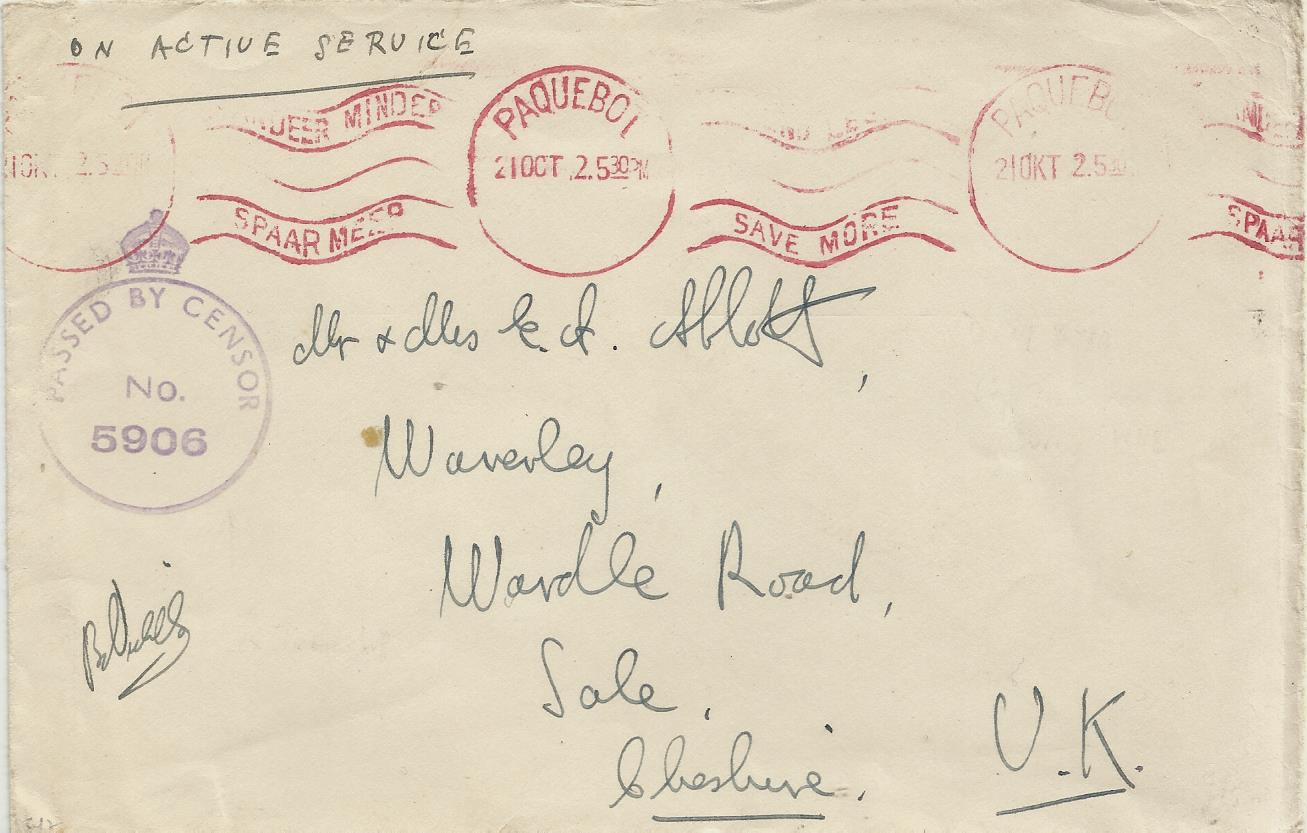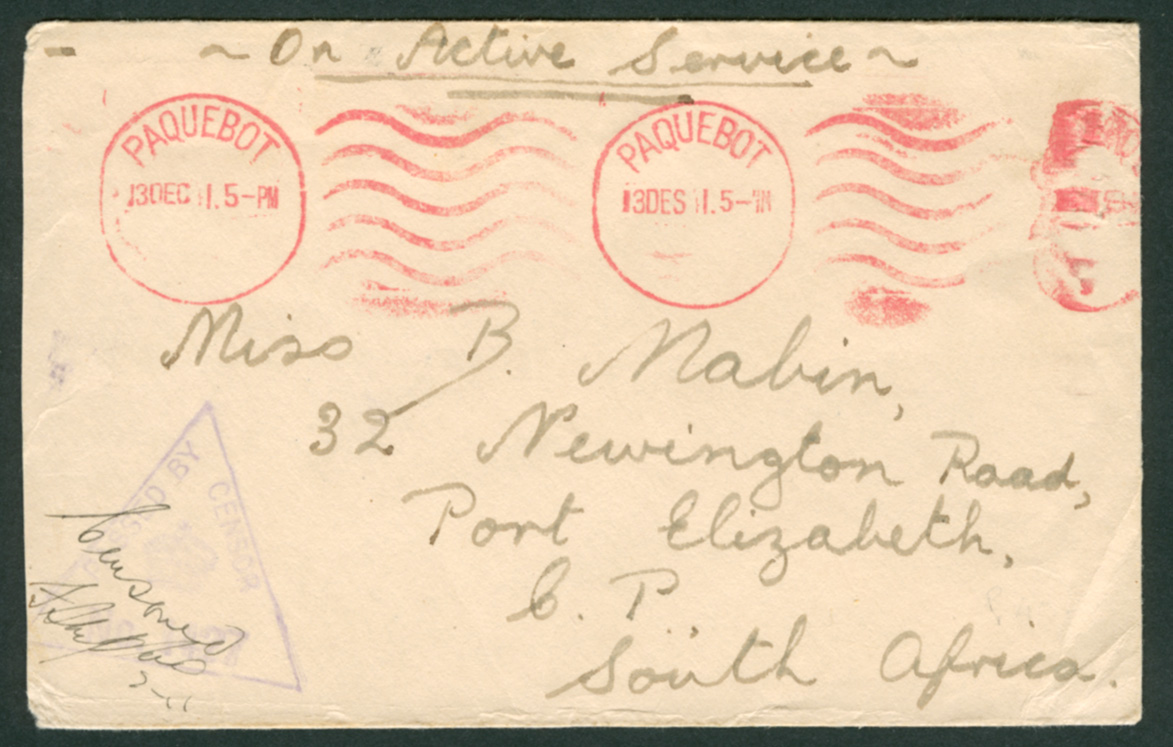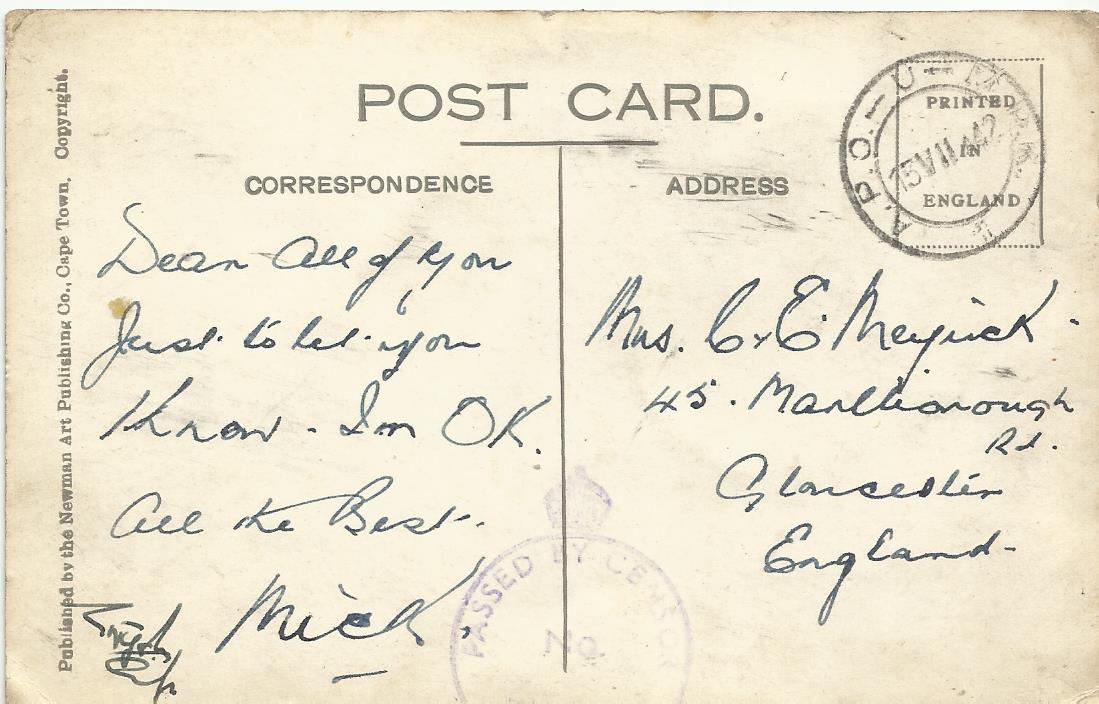SOUTH AFRICAN PAQUEBOT, USE BY BRITISH TROOP SHIP (MAYBE)
Quote from SOLPT1 on July 23, 2021, 1:57 amI attach a scan of a South African paquebot 'roller" cover from World War 2. The roller paquebot also displays the "SAVE MORE - SPEND LESS" slogan which I believe, according to my limited references is previously not recorded. It is censored using Type a.500 censor marker number 5906, which according to the spiel when I purchased was used on a troopship, but this has not been confirmed. My question is, have any members ever seen this censor marker used in South Africa before.
I attach a scan of a South African paquebot 'roller" cover from World War 2. The roller paquebot also displays the "SAVE MORE - SPEND LESS" slogan which I believe, according to my limited references is previously not recorded. It is censored using Type a.500 censor marker number 5906, which according to the spiel when I purchased was used on a troopship, but this has not been confirmed. My question is, have any members ever seen this censor marker used in South Africa before.
Uploaded files:Quote from SOLPT1 on July 23, 2021, 2:10 amI attach a scan of a South African paquebot 'roller" cover from World War 2. The roller paquebot also displays the "SAVE MORE - SPEND LESS" slogan which I believe, according to my limited references is previously not recorded. It is censored using Type a.500 censor marker number 5906, which according to the spiel when I purchased was used on a troopship, but this has not been confirmed. My question is, have any members ever seen this censor marker used in South Africa before.
I attach a scan of a South African paquebot 'roller" cover from World War 2. The roller paquebot also displays the "SAVE MORE - SPEND LESS" slogan which I believe, according to my limited references is previously not recorded. It is censored using Type a.500 censor marker number 5906, which according to the spiel when I purchased was used on a troopship, but this has not been confirmed. My question is, have any members ever seen this censor marker used in South Africa before.
Uploaded files:Quote from Jamie Smith on July 23, 2021, 6:59 amYou have me on this one I have never seen this 'Paquebot' cancellation before. I only have it as a Bloemfontein cancellation. Regarding the censor's cachet to the best of my knowledge it would never have been used in South Africa only as in this case where the cover was censored on board a ship before the cover was landed. More common in North Africa. The Royal Navy never used this type of cachet so it has to be British Forces rounding the Cape for North Africa or Far East. Interesting that no year is given; would the '2' indicate 1942? Is there any indication on the reverse?
Wish I had seen it First!
Well Done!
You have me on this one I have never seen this 'Paquebot' cancellation before. I only have it as a Bloemfontein cancellation. Regarding the censor's cachet to the best of my knowledge it would never have been used in South Africa only as in this case where the cover was censored on board a ship before the cover was landed. More common in North Africa. The Royal Navy never used this type of cachet so it has to be British Forces rounding the Cape for North Africa or Far East. Interesting that no year is given; would the '2' indicate 1942? Is there any indication on the reverse?
Wish I had seen it First!
Well Done!
Quote from Steve on July 23, 2021, 5:32 pmDefinitely an interesting MC and certainly not common. I am curious to know who you are referring to (or not referring to) when you say it is not recorded. Who do you refer to? Putzel does not record MCs, Vermaak is not definitive and only basic while "Paquebot Marks of the World and More" (ex- Hoskings, etc) does not record all the rollers supplied with a MC, only the basic type. So, my point is, there is no proper Paquebot mark reference worthy of the name. For some time I have been collecting southern African Paquebot marks in the hope that one day I will be able to put together a Club Collective Paquebot Reference that will be more comprehensive than what we have (or don't have) right now. That being the case, I would certainly like to include your example, with your permission, of course.
In answer to your question, "No, I have not seen this PBC used on SA mail".
However, as a result of your query, I did a quick search on-line (I am sure you will have done so too) and what I found was quite interesting. While I could find no example of your PBC 5906, I did see several of the same design with different numbers. The interesting thing is that they all appeared on Green Honour envelopes, the ones intended for self-censoring. I find it quite strange that an Honour envelope written "on one's honour" is still subject to a PBC mark. Before I read too much into this, (I am no PBC fundi), your cover is one of the few examples not shown on an Honour envelope. If anyone knows more about this, pray tell!
Jamie, I guess the year is 1941, as it is 1942 in the topmost cover. I bow to your experience in these matters - GB Forces PBC associated with FPOs (Field Post Offices). Perhaps FPO used on board a troopship? Why not?
Below I attach a scan of a Paquebot cover I have. I am uncertain at which SA port it was used in. (I would appreciate help with this.) Without measuring it in great detail it looks like it is the same as the one above which has a slogan. My point is that the "Paquebot Marks of the World and More" would treat these two MCs shown here as the same MC, perhaps showing just one (or the other) with a reference like "Seen with slogan. Several varieties known". Their argument for doing this is that they "would go mad" if they attempted to capture all known MCs. I agree and sympathise but even so do not think their solution is very helpful. I think that collectively we can do better!
Definitely an interesting MC and certainly not common. I am curious to know who you are referring to (or not referring to) when you say it is not recorded. Who do you refer to? Putzel does not record MCs, Vermaak is not definitive and only basic while "Paquebot Marks of the World and More" (ex- Hoskings, etc) does not record all the rollers supplied with a MC, only the basic type. So, my point is, there is no proper Paquebot mark reference worthy of the name. For some time I have been collecting southern African Paquebot marks in the hope that one day I will be able to put together a Club Collective Paquebot Reference that will be more comprehensive than what we have (or don't have) right now. That being the case, I would certainly like to include your example, with your permission, of course.
In answer to your question, "No, I have not seen this PBC used on SA mail".
However, as a result of your query, I did a quick search on-line (I am sure you will have done so too) and what I found was quite interesting. While I could find no example of your PBC 5906, I did see several of the same design with different numbers. The interesting thing is that they all appeared on Green Honour envelopes, the ones intended for self-censoring. I find it quite strange that an Honour envelope written "on one's honour" is still subject to a PBC mark. Before I read too much into this, (I am no PBC fundi), your cover is one of the few examples not shown on an Honour envelope. If anyone knows more about this, pray tell!
Jamie, I guess the year is 1941, as it is 1942 in the topmost cover. I bow to your experience in these matters - GB Forces PBC associated with FPOs (Field Post Offices). Perhaps FPO used on board a troopship? Why not?
Below I attach a scan of a Paquebot cover I have. I am uncertain at which SA port it was used in. (I would appreciate help with this.) Without measuring it in great detail it looks like it is the same as the one above which has a slogan. My point is that the "Paquebot Marks of the World and More" would treat these two MCs shown here as the same MC, perhaps showing just one (or the other) with a reference like "Seen with slogan. Several varieties known". Their argument for doing this is that they "would go mad" if they attempted to capture all known MCs. I agree and sympathise but even so do not think their solution is very helpful. I think that collectively we can do better!
Uploaded files:Quote from SOLPT1 on July 26, 2021, 7:04 amThanks gents, the reference book I have is "THE SPECIAL AND COMMEMORATIVE POSTMARKS, CACHETS AND COVERS OF SOUTH AFRICA 1892-1975" by Hasso G. Reisener, which I picked up very cheaply in Sydney, Australia, in a philatelic society auction, probably because I was the only one interested in bidding for it. Australian collectors are very Australia centric which is good for me suppose. In Chapter 2 they have a fairly comprehensive listing of these slogan cancellers. The paquebot canceller is listed but only with the "SUPPORT THE RED CROSS" slogan with a date of 27 May, 1942.
Thanks gents, the reference book I have is "THE SPECIAL AND COMMEMORATIVE POSTMARKS, CACHETS AND COVERS OF SOUTH AFRICA 1892-1975" by Hasso G. Reisener, which I picked up very cheaply in Sydney, Australia, in a philatelic society auction, probably because I was the only one interested in bidding for it. Australian collectors are very Australia centric which is good for me suppose. In Chapter 2 they have a fairly comprehensive listing of these slogan cancellers. The paquebot canceller is listed but only with the "SUPPORT THE RED CROSS" slogan with a date of 27 May, 1942.
Quote from Steve on July 27, 2021, 7:26 amThank you! I have Reisner's book that you refer to (!) but have never paid any attention to Section 2 (Special Slogan Machine Cancels) until this morning. Great. Another string to my bow. That said, in this regard I think Reisener rather over-exaggerates the 'Special' side of things. Many of these slogan marks are rather ordinary everyday wartime cancels used for propaganda, support, etc., purposes. Thanks for bringing these Paquebot slogan MCs to my attention. I was unaware of both, as is "Paquebot Marks of the World and More".
Regarding your bilingual Paquebot MCs, 'SPEND LESS, SAVE MORE' (top above) and the 'SUPPORT THE RED CROSS' in Reisener that you refer to, assuming that my non-MC slogan Paquebot mark was identified first, then "Paquebot Marks of the World and More" (ex- Hoskings, etc.) would show mine as the 'standard' and probably say of yours something like "known with slogans". While this does provide a documented listing, it is of little help to the collector who, I believe, wants / needs to see a printed or scanned example.
If I can get approval, I will post the Cape Town Paquebot mark section from "Paquebot Marks of the World and More" below so you can see its limited use in terms of identification and get an idea of how its needs to be extended to take account of varieties like yours, etc.
Thank you! I have Reisner's book that you refer to (!) but have never paid any attention to Section 2 (Special Slogan Machine Cancels) until this morning. Great. Another string to my bow. That said, in this regard I think Reisener rather over-exaggerates the 'Special' side of things. Many of these slogan marks are rather ordinary everyday wartime cancels used for propaganda, support, etc., purposes. Thanks for bringing these Paquebot slogan MCs to my attention. I was unaware of both, as is "Paquebot Marks of the World and More".
Regarding your bilingual Paquebot MCs, 'SPEND LESS, SAVE MORE' (top above) and the 'SUPPORT THE RED CROSS' in Reisener that you refer to, assuming that my non-MC slogan Paquebot mark was identified first, then "Paquebot Marks of the World and More" (ex- Hoskings, etc.) would show mine as the 'standard' and probably say of yours something like "known with slogans". While this does provide a documented listing, it is of little help to the collector who, I believe, wants / needs to see a printed or scanned example.
If I can get approval, I will post the Cape Town Paquebot mark section from "Paquebot Marks of the World and More" below so you can see its limited use in terms of identification and get an idea of how its needs to be extended to take account of varieties like yours, etc.
Quote from SOLPT1 on August 6, 2021, 2:46 amWith regards to the use of Type a.500 censor markers from a passing troop ships, using South African postal facilities I attach a copy of a postcard of the Durban Docks, post marked at South African APO 1 on 15 July, 1942. It is also hit with an unreadable a.500 censor marker. Addressed to England.
With regards to the use of Type a.500 censor markers from a passing troop ships, using South African postal facilities I attach a copy of a postcard of the Durban Docks, post marked at South African APO 1 on 15 July, 1942. It is also hit with an unreadable a.500 censor marker. Addressed to England.
Uploaded files:



